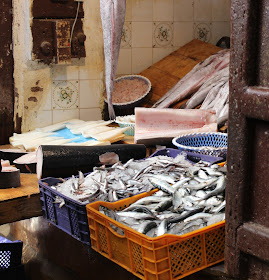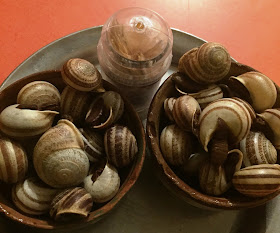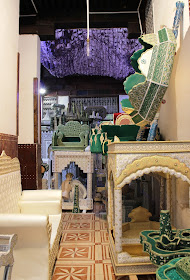I love the word "souk" (pronounced to rhyme with "duke"). It sounds so foreign and so exotic, which is just what a souk is. Every old Arabic city has a souk, which is an open-air marketplace or bazaar. (Actually, I like the equally exotic Persian word "bazaar" as well.)

We didn't spend any time in the Fes souk by ourselves, which I regret, but we did spend a lot of time walking through it with our guide Hassan. However, later in our trip we did spend a lot of time by ourselves in the Marrakech souk, which seemed to me to be more open, less intimidating, and less mysterious than the narrow, darker passageways of Fes, but that is probably because we had been in Morocco longer and were more comfortable in general by that time. While the residential alleyways of Fes were generally quiet and empty, the souk was noisy and crowded. Sometimes the passageways were quite narrow, making for plenty of pushing and jostling, and the claustrophobia was not helped by the occasional goods-laden donkey being led through the maze.
One of the things that really took me by surprise was the food on display in glass cases protruding from dark stalls throughout the souk. Unfamiliar Moroccan dishes were occasionally punctuated with French pastries.
There were plenty of eclairs and millefeuille (bottom left of photo below) for sale. I can't imagine that they were baked in the souk; someone must have a French pastry franchise going on in Fes.
I'm not sure what this delicacy is (Could it be cheese?), but the presentation is beautiful:
One thing the Moroccans did not learn from the French is how to make bread. We were constantly disappointed by the bread, which basically came in two forms, a flat bread that looks like a tortilla or crepe but is a lot more like cardboard:
. . . and the ubiquitous round loaves, made with yeast but patted out into flat circles and dusted with semolina. They are about the size of a small salad plate and are served with every meal. We saw them in stacks on the counters in restaurants and shops everywhere we went, including in the souk. Sitting out all day didn't add much to their moistness. A little bit of this bread goes a long way. It wasn't until we made some ourselves in our cooking class in Marrakech and ate them warm with olive oil for dipping that we thought they were any good. |
| I didn't get a good picture of the stacks of bread in the souks, so I borrowed this picture from here, where you can also see a recipe. |
There were parts of the souk that looked like a farmers' market:
I loved these bags of pink garlic. According to World Food: Morocco by Catherine Hanger, "Moroccan garlic is small and pink, with a sweeter, more fragrant perfume than its European counterpart. Grated rather than chopped into dishes, Moroccan garlic can also be pulverised with mortar and pestle and mixed with salt into a paste. . . . Garlic may be the only ingredient used with such enthusiasm in Moroccan cooking to have been avoided by Mohammed. Apparently he refused a dish containing garlic by explaining that he had to keep close proximity with many people." (Bob, take note.)
There were shops that reminded me of an upscale version of Hadley's Fruit Orchards in Cabazon, a store that specializes in dates:
Moroccans love their olives, and we purchased them a few times from vendors in the souk:
I sure was

We were a bit horrified to learn they were culinary snails, an inexpensive soup ingredient.
On our way back to our riad on our second day in Fes, Hassan stopped at a snail cart where we paid about 60 cents each for a bowl of snails that had been boiled in a heavily seasoned broth. The broth was served separately in another bowl and was delicious.
Bob politely asked permission to take pictures, and the Snail Chef was very accommodating. I think tourists typically walk through and snap photos of whatever they want, creating ill-will with shopkeepers. Hassan told us that this man was appreciative of Bob's respect and courtesy:
Here is one of Bob's pictures of the snails being scooped out of the broth with a slotted spoon:
. . . and another picture of the herbs that are used to season the broth:We should have purchased a bag of those herbs to bring home so we could cook up our own garden snails for dinner. NOT.
Another somewhat bizarre food that we didn't get around to trying is khlii, or meat preserved in lard. Hassan told us that it is a little bit like jerky. Beef is cut in strips, marinated in spices, and then sun-dried before being cooked and stored in a heavy layer of animal fat. It's what you see in the plastic containers and the blue bowls at the front of the display case n the picture below:

Doesn't this pile of lard look appetizing? Yeah, me neither.
Here's another stall with beef and an unusual kind of meat for sale:
Camel meat and camel milk are very healthy. According to a recent article in Britain's The Guardian:
"Camel meat is reputed to be healthier than other red meats such as beef--it is leaner and a good source of protein and vitamin E. And it's not just the meat. Camel milk contains three times the vitamin C of cow's milk and is rich in iron and B vitamins. The UN's Food and Agriculture Organisation says that the potential value of a commercial camel milk industry could be $10bn. So if you are reading this is 10 years' time while tucking into a camel burger washed down with a camel shake, you are probably wondering what the fuss is about."
Muslims, who follow many of the same dietary restrictions as Jews, can eat this meat while Jews cannot. Here is an explanation of why that is so.
We have actually cooked camel meat at home, but Bob had hoped to try some Moroccan recipes using different cuts of camel meat such as steak or roast, or perhaps camel tagine, but when we were in Fes, all that appeared to be available was ground camel, which is what we had for dinner on our second night in Riad Laaroussa:
One of the most intriguing foods we saw being made was what looked like phyllo pastry. Balls of sticky dough were rolled out to make a very thin circle and brushed with butter, then thrown over a hot metal sphere to bake. When one side was done, it was peeled off and flipped over:
The cooked, ultra-thin pancakes were stacked in a pan for later use. We didn't get to see what dish these became part of, but perhaps the millefeuille pastries are baked in the souk after all!
There were many shops that sold items used in Moroccan weddings, including the yellow and white Moroccan wedding carriage in the lower right corner known as an amariah. A bride sits in this and is carried through the streets and into the wedding venue by four men:
I would love to see this in person:
 |
| Photo from this business website called "10 Tips to Throwing a Moroccan Wedding" |
The souk also sells clothing, including Moroccan-made shoes and slippers. I never had the chance to ask if they had a women's size 10, but if I ever go back . . .
Finally, here is another shop where I wish we had stopped, although I can't imagine using a spool of thread as big as one of these:
We did a lot more souk shopping at the end of our trip in Marrakesh, but in comparing the two souks, the Fes souk seems to have a lot more practical shops that are used by the locals than the Marrakesh souk, although there were definitely plenty of tourist spots in the Fes souk.
If I ever make it back to Morocco, I'm definitely planning to spend some more "quality time" in the Fes souk.
































Yeah, the Moroccan bread was pretty nasty for the most part, even when it initially looked really good. How could a place with such French influence end up so wrong? Oh well, they make up for it in other ways.
ReplyDeleteOh dear. I'm now imagining Bob picking your petunia-loving snails and creating a soup for supper.
ReplyDeleteI can't help but notice the bride has a death grip on her wedding carriage. She may be smiling, but she's thinking, "Just don't drop me!"
I want some of those blue bowls holding the khlii.
I could probably get down the lard-covered meat (as long as I was able to prepare it the way I wanted to in my own kitchen), but those snails in the soup? Ai, Dios mio. Interesting tour through the souk--thanks!
ReplyDelete